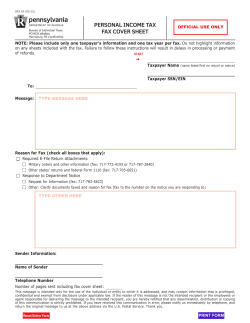
Why are there three level offset adjustments in the MS2720T and
Application Note Why are there three level offset adjustments in the MS2720T and MS271xE Tracking Generators? Introduction There are three different functions used for offsetting amplitude or gain measurements in the MS2720T and MS271xE handheld Spectrum Analyzers, when they have Tracking Generator options installed. This whitepaper explains the differences among and when to use these three functions – RL Offset, Generator External Gain/Loss, and Transmission Offset. Anritsu hand-held Spectrum Analyzers with optional Tracking Generators to 20 GHz. Reference Level (RL) Offset This is used to adjust the power level (not gain) readings on the graph to account for an attenuator or amplifier between the Device Under Test (DUT) and the instrument. In figure 1, you can see that the annotation for the left attenuator in the diagram is highlighted when RL Offset is selected; this attenuator is between the Device Under Test (DUT) and the RF Input on the instrument. Note that the figures that show data entry displays are from an MS2720T. On the MS271xE series, the entries are the same, but the graphics showing the connections will not be present. For example, if you have a high-power amplifier, you probably want to use a high-power-handling attenuator, such as the Anritsu part number 1010-128-R. This particular attenuator can accept 150 Watts, and has 40 dB of attenuation. By setting the RL Offset to “40 dB External Loss”, the instrument will now read the output power level of the amplifier, which is 40 dB higher than what the instrument sees. So if the instrument sees a 0 dBm input, it will display 40 dBm, or 10 Watts. Another example is if you are using the tracking generator option, and your test setup has matching pads between the instrument and the DUT. Again, RL Offset will display the actual power output from the DUT, rather than what the instrument sees. Yet a third use of RL offset is when you are using an external amplifier, such as a very-low-noise preamp to look at very low signal levels. For example, if you have a preamp with 20 dB gain and 5 dB noise figure, this will drop the effective noise floor of the instrument down to about 5 dB above KTB, or about –169 dBm/Hz. However without RL Offset, the noise floor would look about 20 dB higher, due to the gain of the preamp. The signal levels would also look 20 dB higher than the actual values. Setting the RL Offset to “20 dB External Gain” makes the instrument display the noise floor and signal levels at the correct amplitudes. To remind you of the RL Offset setting, right below the Reference Level annotation in the upper-left corner of the display says e.g. “10 dB Ext Loss”. See Figure 2. Figure 1. Reference Level Offset corrects for attenuators or amplifiers between the DUT and RF Input 2 Figure 2. Annotation for Reference Level Offset, in this case 10 dB of External Loss which adds 10 dB to all measured power levels. Generator Ext Gain/Loss This function is very similar to RL Offset, but it corrects the indicated (and set) output amplitude by the gain or loss of an external attenuator or amplifier. In Figure 3, you can see the annotation by the right-hand attenuator, connected to the instrument’s RF output, is now highlighted when Ext Gain/Loss is selected. The most common usage for this is when using a matching pad when connecting to the DUT. It’s also useful if the DUT needs a larger signal than the instrument’s Tracking Generator can provide, and a driver amplifier is used for this purpose. If you have, for example, a 3 dB attenuator between the RF output and the DUT, and you adjust the instrument amplitude to –10 dBm, then the instrument will actually set the output level to –7 dBm, but show that the output is –10 dBm. To remind you of this setting, the generator output amplitude annotation in the upper-right corner of the display (right above the graph) says “ –10 dBm (Ext Loss)”. See Figure 4. Figure 3. When Ext Gain/Loss is selected in the Generator menu, you can correct for attenuators & amplifiers connected to the RF output. Figure 4. The instrument reminds you when Ext Gain/ Loss is set for the Generator. 3 Transmission Offset So far, the 2 offsets are pretty simple—one for the RF Input (RL Offset) and one for the Generator Output (Ext Gain/Loss). Why is a third offset required? Transmission Offset is for use after Normalization, and applies only in a special case where: • The DUT has either so much gain or loss that an attenuator or amplifier needs to be used to compensate for the large DUT gain or loss, i.e. bring the signal level back to where the instrument can measure it in a reasonable amount of time • And –The gain or loss of the compensating attenuator or amplifier is so large that it limits the dynamic range of the measurement – Or the measurement requires a resolution bandwidth so low that the measurement takes too long – Or the attenuator isn’t separable from the DUT (such as using a test port). For example, a TV transmitter might take in a 0 dBm signal, and output 10 kW (+70 dBm). The transmitter is somewhat non-linear, and it’s desired (or even necessary) to measure its frequency response at full output power. However the output of the TV transmitter is far beyond what the instrument can handle, necessitating an attenuator before the instrument input of at least 40 dB, and often much greater. Assume that only a 70 dB attenuator is available with the requisite power handling (or equivalently that there is a test port from the transmitter at 70 dB below the output amplitude). This reduces the signal amplitude to 0 dBm. However if the attenuator is used as part of the Normalization, the signal amplitude into the instrument is now –70 dBm. While this certainly can be measured, it necessitates using a Resolution Bandwidth (RBW) of around 1 kHz for good SNR (during the normalization), which can slow the sweep significantly. Normalizing without the attenuator allows a much wider RBW, and therefore faster sweep times. When measuring the example 0 dBm signal from the DUT, wide RBW is also sufficient (assuming that frequency resolution isn’t limited by this). In the case where a test port is used, Transmission Offset allows the instrument to show the actual gain of the DUT to the output, rather than the gain to the test port. You can see how Transmission Offset is entered in Figure 5. 4 Another example is measuring a very high-loss device, for example looking at the rejection of a well-made cavity filter. At frequencies below about 10 GHz, Anritsu handheld Spectrum Analyzers with a Tracking Generator option can measure over 120 dB down to a filter skirt, but the measurement can take a very long time as the RBW that must be used for this is 1 Hz. Instead, we can combine the DUT with an amplifier that has an output capability greater than what the Tracking Generator can provide. If you did the Normalization using the amplifier, the output level would be too high, and the instrument’s attenuator would need to be set at a high level – counteracting the advantage of the amplifier. If instead the Normalization was done without the amplifier, low attenuation could be used in the instrument, allowing the use of wide RBW when measuring the filter skirt (but not the filter passband – that would overdrive the instrument’s front-end). Using Transmission Offset to compensate for the amplifier’s gain allows showing the actual skirt amplitude. Figure 5. Transmission Offset compensates for amplifiers or attenuators added after Normalization. 5 Transmission Offset vs. Trace Math While simple & quick, the Transmission Offset function has a key limitation – the frequency response of the amplifier or attenuator that’s being compensated isn’t included in the Normalization. Often, the measurement isn’t over a wide enough frequency range that this matters, or the variation is small enough that it’s swamped by the measurement uncertainty. However if the frequency range is such that you care about this response, the instrument has a tool to help with that too – trace math. The concept is simple—just measure the frequency response of the compensating device, then use trace math to subtract this from the final measurement. The steps are: 1. Set up the frequency range of the instrument 2. Set up the Generator Output Power, in Tracking mode to an optimal value. This is often 0 dBm. 3. Normalize the instrument 4. Measure the frequency response of the compensating attenuator or amplifier 5. Store the response into trace B (Shift, Trace, Trace B, A->B) 6. Set Trace C to A-B mode (Shift Trace, Trace C, A-B->C) 7. Disconnect the compensating attenuator or amplifier 8.Depending on the DUT, you might want to change the Generator’s Output Power at this point. If so, you’ll need to re-normalize. 9. Blank traces A & B, and set the Active trace to C 10. Connect the DUT 11.Be sure to use the right-hand scale for these measurements. See Figure 6 for an example using trace math along with Normalization. 6 Figure 6. Example result using Trace Math along with Normalization. Use the right-hand scale in this case—about 25 dB loss on average for this display. Note that trace math for normalized traces is only available in the MS2720T as of this writing (March 2013). This function is expected to be added to the MS271xE series in a firmware release in the near future. 7 • United States Anritsu Company • Italy Anritsu S.r.l. • Singapore Anritsu Pte. Ltd. 1155 East Collins Blvd., Suite 100, Richardson, TX 75081, U.S.A. Toll Free: 1-800-267-4878 Phone: +1-972-644-1777 Fax: +1-972-671-1877 Via Elio Vittorini 129, 00144 Roma, Italy Phone: +39-6-509-9711 Fax: +39-6-502-2425 60 Alexandra Terrace, #02-08, The Comtech (Lobby A) Singapore 118502 Phone: +65-6282-2400 Fax: +65-6282-2533 • Canada Anritsu Electronics Ltd. 700 Silver Seven Road, Suite 120, Kanata, Ontario K2V 1C3, Canada Phone: +1-613-591-2003 Fax: +1-613-591-1006 • Sweden Anritsu AB Borgarfjordsgatan 13A, 164 40 KISTA, Sweden Phone: +46-8-534-707-00 Fax: +46-8-534-707-30 • Finland Anritsu AB • Brazil Anritsu Eletrônica Ltda. Teknobulevardi 3-5, FI-01530 VANTAA, Finland Phone: +358-20-741-8100 Fax: +358-20-741-8111 Praça Amadeu Amaral, 27 - 1 Andar 01327-010 - Bela Vista - São Paulo - SP - Brazil Phone: +55-11-3283-2511 Fax: +55-11-3288-6940 • Denmark Anritsu A/S (Service Assurance) Anritsu AB (Test & Measurement) • Mexico Anritsu Company, S.A. de C.V. Av. Ejército Nacional No. 579 Piso 9, Col. Granada 11520 México, D.F., México Phone: +52-55-1101-2370 Fax: +52-55-5254-3147 • United Kingdom Anritsu EMEA Ltd. 200 Capability Green, Luton, Bedfordshire, LU1 3LU, U.K. Phone: +44-1582-433280 Fax: +44-1582-731303 • France Anritsu S.A. Kay Fiskers Plads 9, 2300 Copenhagen S, Denmark Phone: +45-7211-2200 Fax: +45-7211-2210 • Russia Anritsu EMEA Ltd. • P.R. China (Shanghai) Anritsu (China) Co., Ltd. Room 1715, Tower A CITY CENTER of Shanghai, No.100 Zunyi Road, Chang Ning District, Shanghai 200051, P.R. China Phone: +86-21-6237-0898 Fax: +86-21-6237-0899 • P.R. China (Hong Kong) Anritsu Company Ltd. Unit 1006-7, 10/F., Greenfield Tower, Concordia Plaza, No. 1 Science Museum Road, Tsim Sha Tsui East, Kowloon, Hong Kong, P.R. China Phone: +852-2301-4980 Fax: +852-2301-3545 • Japan Anritsu Corporation 8-5, Tamura-cho, Atsugi-shi, Kanagawa, 243-0016 Japan Phone: +81-46-296-1221 Fax: +81-46-296-1238 Representation Office in Russia Tverskaya str. 16/2, bld. 1, 7th floor. Russia, 125009, Moscow Phone: +7-495-363-1694 Fax: +7-495-935-8962 • Korea Anritsu Corporation, Ltd. • United Arab Emirates Anritsu EMEA Ltd. 12 avenue du Québec, Bâtiment Iris 1- Silic 612, 91140 VILLEBON SUR YVETTE, France Phone: +33-1-60-92-15-50 Fax: +33-1-64-46-10-65 Dubai Liaison Office P O Box 500413 - Dubai Internet City Al Thuraya Building, Tower 1, Suite 701, 7th Floor Dubai, United Arab Emirates Phone: +971-4-3670352 Fax: +971-4-3688460 • Germany Anritsu GmbH • India Anritsu India Private Limited Nemetschek Haus, Konrad-Zuse-Platz 1 81829 München, Germany Phone: +49-89-442308-0 Fax: +49-89-442308-55 2nd & 3rd Floor, #837/1, Binnamangla 1st Stage, Indiranagar, 100ft Road, Bangalore - 560038, India Phone: +91-80-4058-1300 Fax: +91-80-4058-1301 502, 5FL H-Square N B/D, 681 Sampyeong-dong, Bundang-gu, Seongnam-si, Gyeonggi-do, 463-400 Korea Phone: +82-31-696-7750 Fax: +82-31-696-7751 • Australia Anritsu Pty. Ltd. Unit 21/270 Ferntree Gully Road, Notting Hill, Victoria 3168, Australia Phone: +61-3-9558-8177 Fax: +61-3-9558-8255 • Taiwan Anritsu Company Inc. 7F, No. 316, Sec. 1, NeiHu Rd., Taipei 114, Taiwan Phone: +886-2-8751-1816 Fax: +886-2-8751-1817 Anritsu prints on recycled paper with vegetable soybean oil ink. ®Anritsu All trademarks are registered trademarks of their respective companies. Data subject to change without notice. For the most recent specifications visit: www.anritsu.com Application Note No. 11410-00713, Rev. A Printed in United States 2013-04 ©2013 Anritsu Company. All Rights Reserved.
© Copyright 2025












